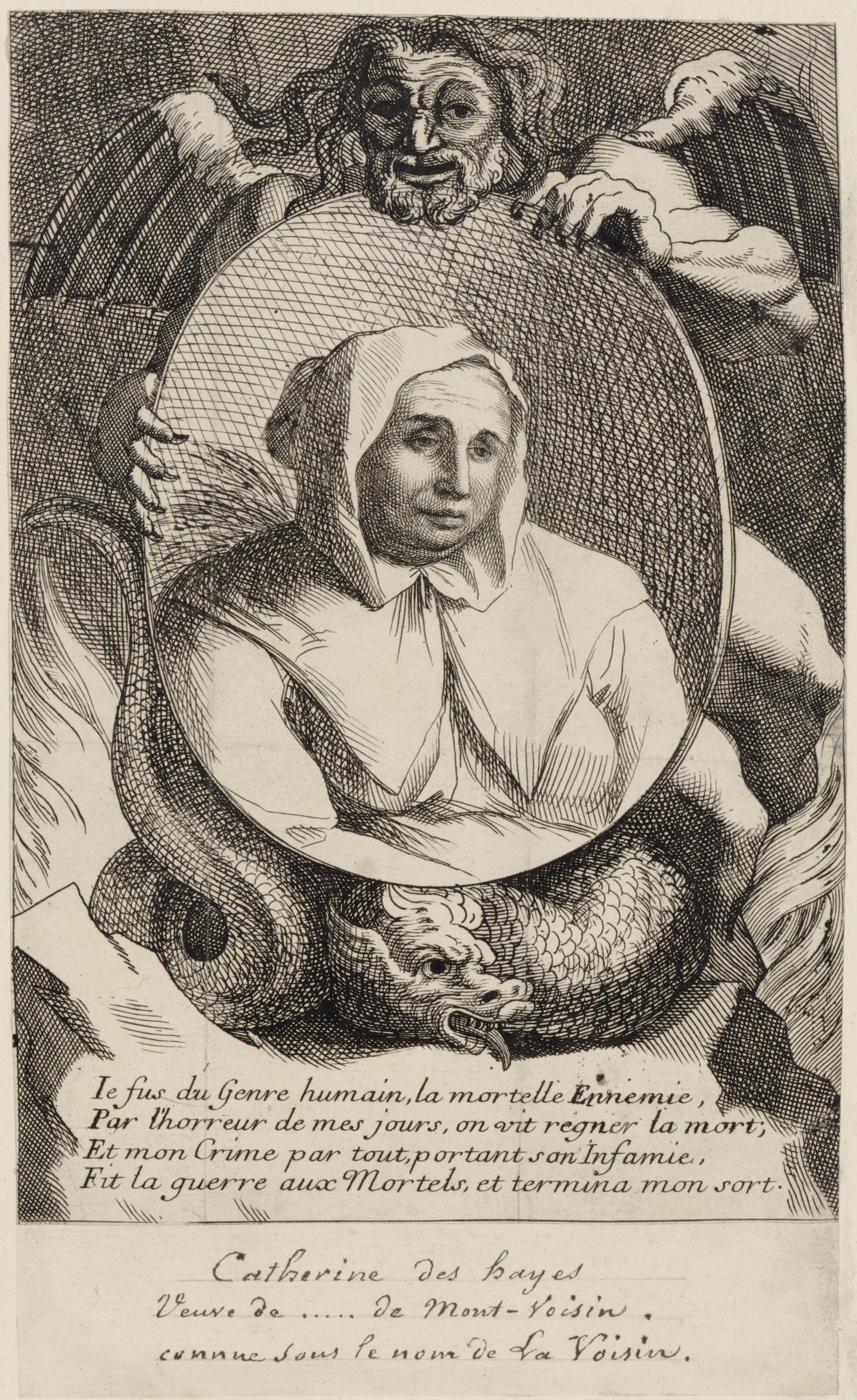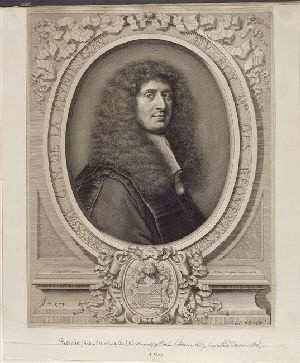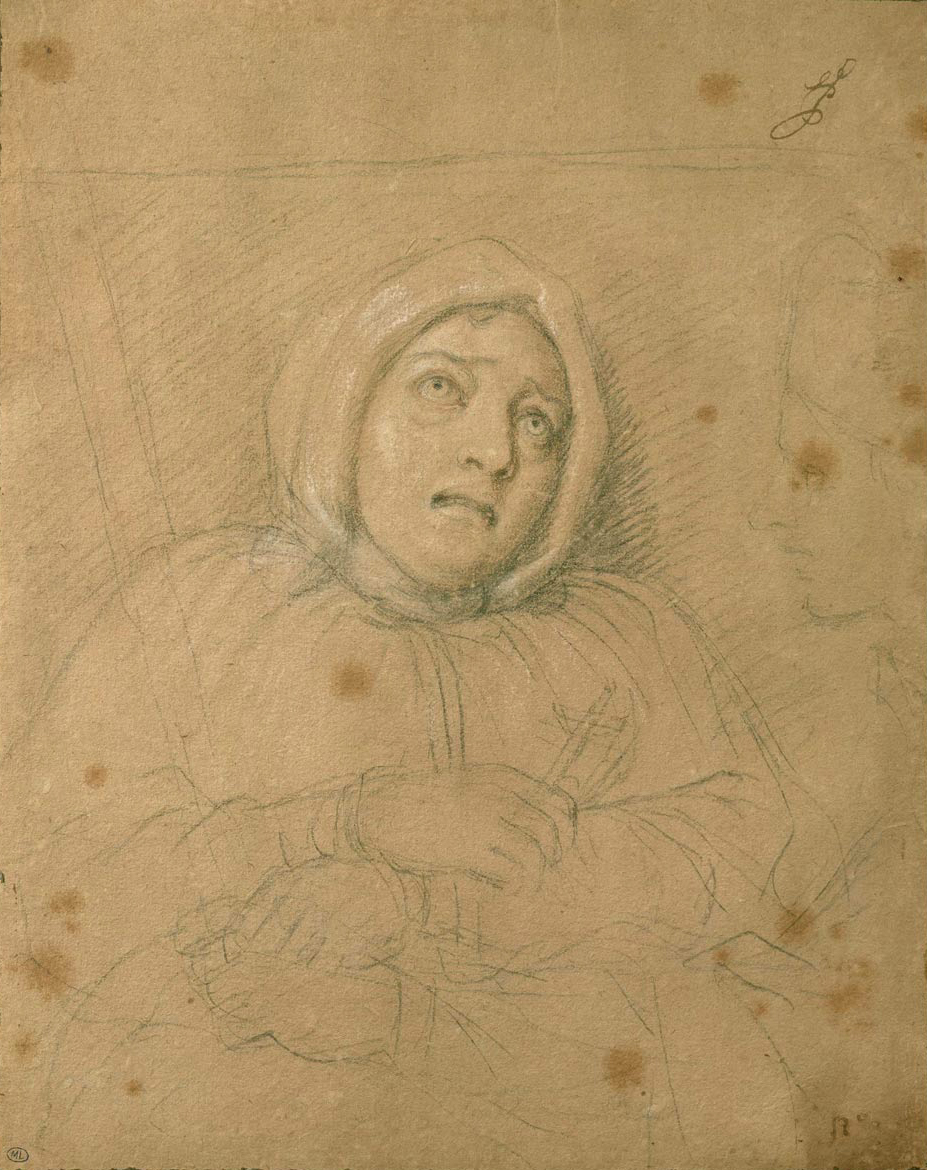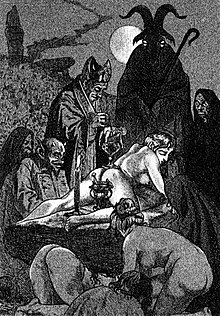Hi,
Maybe it's time for another thing ?
Let's go centuries back ?
This thread will talk about the "Affair of the poisons",a scandal in the French kingdom and one of the most sensational criminal cases of the time.
Things weren't that bright at the Sun King's court.
@WebMaster @Scorpion @Legend @BLACKEAGLE @Zepplin @Gasoline @Falcon29 @pwarbi
etc.
It might interest you..
-

Catherine Deshayes, "La Voisin", 17th-century print of her portrait held by a winged devil.
The Affair of the Poisons (L'affaire des poisons) was a major murder scandal in France which took place in 1677–1682, during the reign of King Louis XIV. During it, a number of prominent members of the aristocracy were implicated and sentenced on charges of poisoning and witchcraft. The scandal reached into the inner circle of the king. It led to the execution of 36 people.

Gabriel-Nicolas de la Reynie (1625–1709),
Context and origin
The origin of the case began in 1675 after the trial of Madame de Brinvilliers, who was accused of having conspired with her lover, army captain Godin de Sainte-Croix, to poison her father Antonine Dreux d'Aubray in 1666 and two of her brothers, Antoine d'Aubray and François d'Aubray, in 1670, in order to inherit their estates. There were also rumors that she had poisoned poor people during her visits in hospitals. After being accused she fled, but was arrested in Liège. Brinvilliers was tortured and confessed, was sentenced to death, and on 17 July was tortured with the water cure (forced to drink sixteen pints of water), beheaded, and her body burned at the stake. Her alleged accomplice Sainte-Croix did not face charges because he had died of natural causes in 1672.
The sensational trial drew attention to a number of other mysterious deaths, starting a number of rumours. Prominent people, including Louis XIV, became alarmed that they might be poisoned.

Marie Madeleine Marguerite d'Aubray, Marquise de Brinvilliers, 1676, after her imprisonment,
Implications and investigation
The affair proper opened in February 1677 after the arrest of Magdelaine de La Grange on charges of forgery and murder. La Grange appealed to François Michel le Tellier,Marquis of Louvois,claiming that she had information about other crimes of high importance. Louvois reported to the king, who told Gabriel Nicolas de la Reynie, who, among other things, was the chief of the Paris police, to root out the poisoners. La Reynie sought to calm the king. The subsequent investigation of potential poisoners led to accusations of witchcraft, murder and more.
Their investigation, which continued for the next three years, uncovered the presence of a criminal magical underworld flourishing in the very heart of the capital. Sorceresses, magicians, and renegade priests, among others, were conducting a lively business in spells, magical ceremonies, and a variety of poisons.
Authorities rounded up a number of fortune tellers and alchemists who were suspected of selling not only divinations,séances and aphrodisiacs, but also "inheritance powders" (a euphemism for poison). Some of them confessed under torture and gave authorities lists of their clients, who had allegedly bought poison to get rid of their spouses or rivals in the royal court.
The most famous case was that of midwife Catherine Deshayes Monvoisin or La Voisin, who was arrested in 1679 after she was incriminated by the poisoner Marie Bose. La Voisin implicated a number of important individuals in the French court. These included Olympia Mancini, the Comtesse de Soissons, her sister Marie Anne Mancini Duchesse de Bouillon, François Henry de Montmorency,Duke of Luxembourg and, most importantly, the king's mistress, Athénaïs de Motespan.
Questioned while intoxicated, La Voisin claimed that Madame de Montespan had bought aphrodisiacs and performed black masses with her in order to gain and keep the king's favor over rival lovers.
An black mass, celebrated over the body of a naked woman, allegedly lured forth demons with the sacrifice of an infant for the purpose of establishing control over another’s heart, mind and will.
She had worked with a priest named Etienne Guibourg.
There was no evidence beyond her confessions, but bad reputations followed these people afterwards. Eleanor Herman, in her book Sex with Kings, claims that the police, given reports of "babies' bones", uncovered the remains of 2,500 infants in La Voisin's garden.

Also involved in the scandal was Eustache Dauger de Cavoye, the eldest living scion of a prominent noble family. Cavoye was disinherited by his family when, in an act of debauchery, he chose to celebrate Good Friday with a black mass. Upon his disinheritance, he opened a lucrative trade in "inheritance powders" and aphrodisiacs. He mysteriously disappeared after the abrupt ending of Louis's official investigation in 1678. Because of this and his name, he was once suspected of being the Man in the Iron Mask. However, this theory has fallen out of favor because it is known that he was imprisoned by his family in 1679 in the prison of Saint-Lazare.
The end of the trial
La Voisin was sentenced to death for witchcraft and poisoning, and burned at the stake on 22 February 1680. Marshal Montmorency-Bouteville was briefly jailed in 1680, but was later released and became a captain of the guard. Minister Jean-Baptiste Colbert helped to hush things up.
De La Reynie re-established the special court, the Chambre Ardente ("burning court"), to judge cases of poisoning and witchcraft. It investigated a number of cases, including many connected to nobles and courtiers in the king's court. Over the years, the court sentenced 34 people to death for poisoning or witchcraft. Two died under torture and several courtiers were exiled. The court was abolished in 1682, because the king could not risk the publicity of such scandal. To this, Police Chief Reynie said "the enormity of their crimes proved their safeguard."
Condemned in the Poison Affair
The Poison Affair implicated 442 suspects: 367 orders of arrests were issued, of which 218 were carried out. Of the condemned, 36 were executed; five were sentenced to the galleys; and 23 to exile. This excludes those who died in custody by torture or suicide. Additionally, many accused were never brought to trial, but placed outside of the justice system and imprisoned for life by a lettre de cachet.
Of the people who were condemned to perpetual imprisonment by lettre de cachet, six women were imprisoned at Chäteau de Villefranche; 18 men at Château de Salces; 12 women at Belle-île-en-Mer; ten men at Château de Besançon; 14 women at St Andre de Salins; and five women at Fort de Bains.
https://en.wikipedia.org/wiki/Affair_of_the_Poisons
Maybe it's time for another thing ?
Let's go centuries back ?
This thread will talk about the "Affair of the poisons",a scandal in the French kingdom and one of the most sensational criminal cases of the time.
Things weren't that bright at the Sun King's court.
@WebMaster @Scorpion @Legend @BLACKEAGLE @Zepplin @Gasoline @Falcon29 @pwarbi
etc.
It might interest you..
-

Catherine Deshayes, "La Voisin", 17th-century print of her portrait held by a winged devil.
The Affair of the Poisons (L'affaire des poisons) was a major murder scandal in France which took place in 1677–1682, during the reign of King Louis XIV. During it, a number of prominent members of the aristocracy were implicated and sentenced on charges of poisoning and witchcraft. The scandal reached into the inner circle of the king. It led to the execution of 36 people.

Gabriel-Nicolas de la Reynie (1625–1709),
Context and origin
The origin of the case began in 1675 after the trial of Madame de Brinvilliers, who was accused of having conspired with her lover, army captain Godin de Sainte-Croix, to poison her father Antonine Dreux d'Aubray in 1666 and two of her brothers, Antoine d'Aubray and François d'Aubray, in 1670, in order to inherit their estates. There were also rumors that she had poisoned poor people during her visits in hospitals. After being accused she fled, but was arrested in Liège. Brinvilliers was tortured and confessed, was sentenced to death, and on 17 July was tortured with the water cure (forced to drink sixteen pints of water), beheaded, and her body burned at the stake. Her alleged accomplice Sainte-Croix did not face charges because he had died of natural causes in 1672.
The sensational trial drew attention to a number of other mysterious deaths, starting a number of rumours. Prominent people, including Louis XIV, became alarmed that they might be poisoned.

Marie Madeleine Marguerite d'Aubray, Marquise de Brinvilliers, 1676, after her imprisonment,
Implications and investigation
The affair proper opened in February 1677 after the arrest of Magdelaine de La Grange on charges of forgery and murder. La Grange appealed to François Michel le Tellier,Marquis of Louvois,claiming that she had information about other crimes of high importance. Louvois reported to the king, who told Gabriel Nicolas de la Reynie, who, among other things, was the chief of the Paris police, to root out the poisoners. La Reynie sought to calm the king. The subsequent investigation of potential poisoners led to accusations of witchcraft, murder and more.
Their investigation, which continued for the next three years, uncovered the presence of a criminal magical underworld flourishing in the very heart of the capital. Sorceresses, magicians, and renegade priests, among others, were conducting a lively business in spells, magical ceremonies, and a variety of poisons.
Authorities rounded up a number of fortune tellers and alchemists who were suspected of selling not only divinations,séances and aphrodisiacs, but also "inheritance powders" (a euphemism for poison). Some of them confessed under torture and gave authorities lists of their clients, who had allegedly bought poison to get rid of their spouses or rivals in the royal court.
The most famous case was that of midwife Catherine Deshayes Monvoisin or La Voisin, who was arrested in 1679 after she was incriminated by the poisoner Marie Bose. La Voisin implicated a number of important individuals in the French court. These included Olympia Mancini, the Comtesse de Soissons, her sister Marie Anne Mancini Duchesse de Bouillon, François Henry de Montmorency,Duke of Luxembourg and, most importantly, the king's mistress, Athénaïs de Motespan.
Questioned while intoxicated, La Voisin claimed that Madame de Montespan had bought aphrodisiacs and performed black masses with her in order to gain and keep the king's favor over rival lovers.
An black mass, celebrated over the body of a naked woman, allegedly lured forth demons with the sacrifice of an infant for the purpose of establishing control over another’s heart, mind and will.
She had worked with a priest named Etienne Guibourg.
There was no evidence beyond her confessions, but bad reputations followed these people afterwards. Eleanor Herman, in her book Sex with Kings, claims that the police, given reports of "babies' bones", uncovered the remains of 2,500 infants in La Voisin's garden.

Also involved in the scandal was Eustache Dauger de Cavoye, the eldest living scion of a prominent noble family. Cavoye was disinherited by his family when, in an act of debauchery, he chose to celebrate Good Friday with a black mass. Upon his disinheritance, he opened a lucrative trade in "inheritance powders" and aphrodisiacs. He mysteriously disappeared after the abrupt ending of Louis's official investigation in 1678. Because of this and his name, he was once suspected of being the Man in the Iron Mask. However, this theory has fallen out of favor because it is known that he was imprisoned by his family in 1679 in the prison of Saint-Lazare.
The end of the trial
La Voisin was sentenced to death for witchcraft and poisoning, and burned at the stake on 22 February 1680. Marshal Montmorency-Bouteville was briefly jailed in 1680, but was later released and became a captain of the guard. Minister Jean-Baptiste Colbert helped to hush things up.
De La Reynie re-established the special court, the Chambre Ardente ("burning court"), to judge cases of poisoning and witchcraft. It investigated a number of cases, including many connected to nobles and courtiers in the king's court. Over the years, the court sentenced 34 people to death for poisoning or witchcraft. Two died under torture and several courtiers were exiled. The court was abolished in 1682, because the king could not risk the publicity of such scandal. To this, Police Chief Reynie said "the enormity of their crimes proved their safeguard."
Condemned in the Poison Affair
The Poison Affair implicated 442 suspects: 367 orders of arrests were issued, of which 218 were carried out. Of the condemned, 36 were executed; five were sentenced to the galleys; and 23 to exile. This excludes those who died in custody by torture or suicide. Additionally, many accused were never brought to trial, but placed outside of the justice system and imprisoned for life by a lettre de cachet.
Of the people who were condemned to perpetual imprisonment by lettre de cachet, six women were imprisoned at Chäteau de Villefranche; 18 men at Château de Salces; 12 women at Belle-île-en-Mer; ten men at Château de Besançon; 14 women at St Andre de Salins; and five women at Fort de Bains.
https://en.wikipedia.org/wiki/Affair_of_the_Poisons

 Lazy. If there is a related documentary please post it.
Lazy. If there is a related documentary please post it.